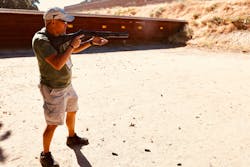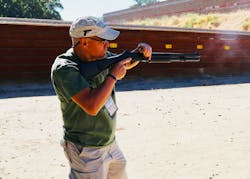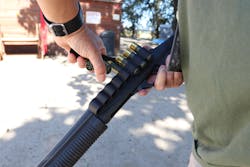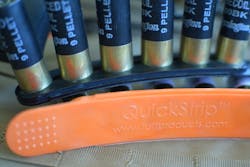The 70mm payload launcher is still one of the most versatile tools in the law enforcement toolbox. Like the revolver, the shotgun is still the king of reliability and cartridge effectiveness.
The shotgun shell trumps a lot of cartridge choices in the inventory. A 12-gauge gun is a reasonable response to many tactical situations, given the flexibility of the shell. For example, slugs can run anywhere from 900 to 2,500 ft. lbs. of muzzle energy, depending on the weight and velocity of the load. 9mm +P loads rarely exceed 500 ft. lbs, and the best duty cartridges hover around 350 to 420 ft. lbs. Most duty shotguns are capable of short carbine-like accuracy.
Most law enforcement handguns and carbines hold more rounds than a shotgun, but a shotgunner who trains can have pretty good fire continuity. This requires having a gun that holds a few extra rounds externally.
The number one thing we need to learn about shotguns is how to keep them fed. Before we go there, we should look at some recent innovations that allow officers to carry more, and more efficiently. I know we are looking at mostly pump shotguns, but everything here is appropriate for autoloading shotguns also. I predict that Remington and Mossberg will put a mag catch and feed system on their popular autoloaders using the same magazines on their pump guns sooner or later.
Remington 870 DM
Many companies have experimented with detachable magazine fed shotguns, and I was waiting for an 870 based one. Remington did not disappoint anyone with the DM models. The Remington uses three and six round magazines. This gun has controls exactly like the 870, except it takes box magazines. These magazines change the balance of the shotgun. At this time, I prefer the original tubular magazines, but a detachable magazine really works for many users.
Armscor VR Series of Shotguns
The VR60 Shotgun is an autoloading shotgun with a similar form factor and controls as an AR-15. This is a gas operated shotgun whose reciprocating action is located around the support tube below the barrel. This gun was so easy to use, it was intuitive. My tests show that I could deliver a lot of accurate fire in a very short time.
The Armscor VR60 has a simple take down. With an MSRP of $499, it is worth considering as a law enforcement tool.
Mossberg 590M (and 590M Shockwave)
The Mossberg 590M is the detachable magazine version of the tube fed 590. The Shockwave version sports the shortened Raptor Grip. Mossberg is serious about their shotgun magazines, offering them in double stack 20, 15, 10, 5 round models.
Shotgun shells can vary a bit in dimension, shape and weight. Because of this, it is challenging to make a magazine for them. A magazine that works for one type of shell may not work reliably for another.
Should we mix shells?
When we were looking at this in my own (and surrounding) agencies, this seemed like a good idea. While training, we made several observations:
- Even in a training environment, no officer had an accurate count of the rounds in their magazine or on the carrier, once they got shooting.
- In rapidly changing environments, no one could make the correct shell choice with reliability, if there is more than one choice.
- Training to extract a live shell from the chamber in order to switch shells was counterintuitive.
- The differences between slugs and buckshot at close range were nominal. In fact, at close ranges, many shotgun payloads behave in similar fashion.
Knowing this, what’s the best shell to use? Initially we used #4 buckshot, and our logic was pretty solid. #4 buckshot (not #4 shot) is very effective at close range and has reduced penetration. The obvious limitation is that all shot expands past the muzzle, some more rapidly than others.
The first two rounds in my magazine in my 870 were buckshot, the rest were slugs. It would be a waste of time to explain the flawed logic here. The fact is, using the same cartridge and having a consistent training plan and policy takes a factor out of the officer’s decision-making process.
As an agency, we went to 100 percent slugs, and tailored the training and policy to reflect this practice. The truth is, agencies can use both buckshot and slugs, but each shotgun should deploy their guns full of one or the other.
Keeping the gun fed
The trick to quickly loading a tube magazine shotgun is to remember one thing: The thumb contacts the base. Sometimes, we tell shooters to put the tip of the thumb on the primer. We have to build this as muscle memory. Every time we load our (tube magazine fed) shotgun, we should keep it shouldered, pointing it downrange. This practice should be exercised even when we are loading up at the start of shift.
I load my guns pointed in a safe direction, safety off. Using the slide release, I fully cycle the slide, looking in the chamber and putting my fingers on the top of the carrier (on Mossberg products, this is called an elevator) and feeling for the magazine follower to ensure I am not putting a live shell into the chamber. Continuing to point the firearm in a safe direction, I put the gun into battery and pull the trigger. This will allow me to rack the slide of a loaded gun and fire immediately. That is, starting out with nothing in the chamber is a particularly safe carry.
After pulling the trigger, I load the magazine. I handle shells by picking them up by the base, then placing the thumb of the non-trigger hand to push the shell into the magazine. Holding the shotshell with the thumb on the primer encourages the shooter to have a tactile confirmation that the shell is pushed all the way home, and it is oriented in the correct direction.
Since most LE shotguns are loaded by bringing the shell into the bottom port and pushing the shell into the magazine, it is also fine to use a cupped hand to put shells in, then pushing with the thumb.
Although it is considerably more efficient to do it the way three gunners do it, the officer’s eye would be taken away from the sighting plane. Three gunners turn the gun upside down on the shoulder and pump at least two at a time in the magazine. If this is your practiced skill, and it works for you, do not abandon it.
Officers can keep the gun on the shoulder and continue to load in this manner. During a firefight, stuff shells into the magazine until no more shells will go in.
Use an external carrier
The quickest reload comes from the external carrier. I carry my shells in an external carrier in a certain pattern. The one farthest forward is always primer up. The rest are all primer down. I usually center each shell so it is unlikely to be accidentally knocked out of the carrier, while allowing me to pinch the base of the shell.
When reloading while shooting, I grab the “primer down” shells, beginning at the one closest to my cheek. I pinch the base, placing my thumb on the primer, then press it into the magazine. The “primer up” shell is for an empty magazine, empty chamber. In this case, I leave the chamber open and pull this shell out of the carrier with my non-shooting hand, keeping my thumb on the primer. I curl my fingers around this shell slightly. This shell is facing forward, radially in line with the ejection port, either touching the top of the gun, or close to touching it.
Keeping my gun on my shoulder, I rotate the gun slightly less than 90 degrees on the axis of the barrel, so the ejection port faces up. The hand with the shell stays put. The chamber is rotated until the shell in my hand falls into it. I push the slide forward and engage, or fill the magazine with the other shells in the carrier.Shells in the pocket
It’s a really great idea to keep some extra shells in the pocket. I don’t know of a better way to do this except by using Tuff Products QuickStrips. Yes, they even make them for 12-gauge shells.
12 gauge QuickStrips are great for feeding single and double barrel shotguns. Tuff Products QuickStrips are flexible injection molded urethane strips that hold cartridges, or in this case, shells, in a row . Cowboy action shooters use them because they allow lightning fast reloads. For Law Enforcement, the idea is to keep them in the cargo pocket where the officer can peel rounds off of them that are always oriented. Since they are very inexpensive, it is handy to have a strip in the pocket.
When I’m practicing reloading my shotguns, there is one thing you should know. I repeat my mantra, “stay in the fight, stay in the fight.” Stay safe, brothers and sisters.






